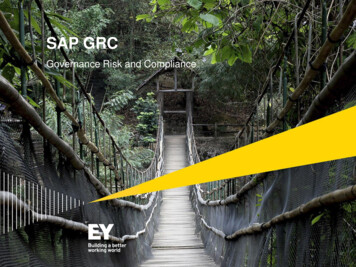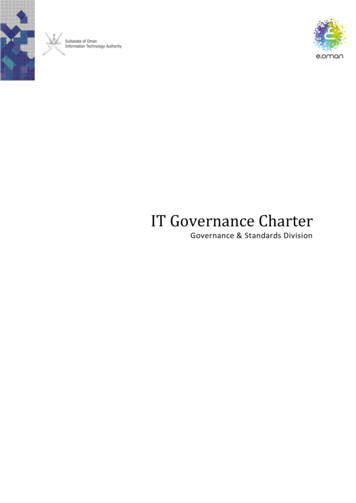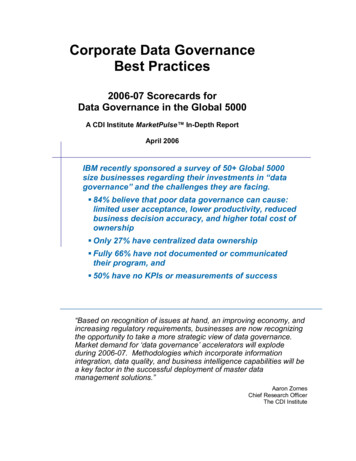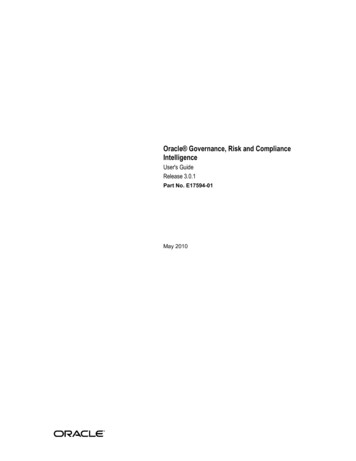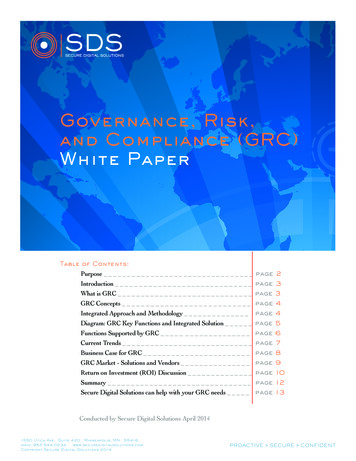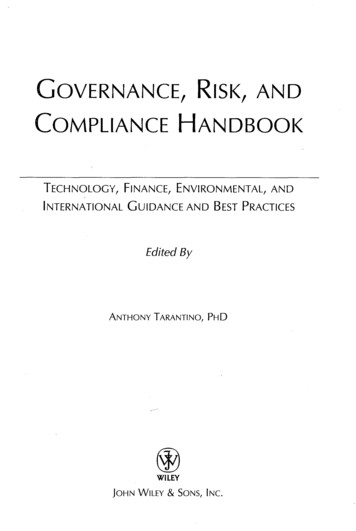
Transcription
GOVERNANCE, RISK, ANDCOMPLIANCE HANDBOOKTECHNOLOGY, FINANCE, ENVIRONMENTAL, A N DINTERNATIONAL GUIDANCE AND BEST PRACTICESEdited ByANTHONY TARANTINO, P H DWILEYJOHN WILEY & SONS, INC.
CONTENTSPrefaceAcknowledgmentsAbout the ContributorsCHAPTER 1XXXIIIXXXVxxxvii1INTRODUCTION1.1Act Locally, Impact Globally1.2Governance1.3Risk1.4 - Compliance and Internal Controls1.5GRC and Globalization1.6Growth of Global Trade1.7Simple Suggestions to Improve Governance,Risk Management, and Compliance (GRC)1.8Why Read This Book: The Case for Good GRC1.9Organization of the HandbookPART 1 Corporate GovernanceCHAPTER 22.12.22.32.42.52.62.72.8330353639A RISK-BASED APPROACH TO ASSESS INTERNALCONTROL OVER FINANCIAL REPORTINGCHAPTER1215212530A Risk-Based Approach to Assessing ICFRDetermine Key StakeholdersEstablish the Risk Management ContextRisk Rating and Risk IdentificationAnalyze and Evaluate RisksTreat/Mitigate RisksIdentify, Assess, and Report on Residual RiskStatusConcluding RemarksCOSO—Is IT3.1(ICFR)FIT FOR PURPOSE?The Roots of COSOIX4142424447515262646566
x CONTENTS3.23.8COSO the Committee and COSO the 1992Integrated Control Framework: Have TheyStood the Test of Time?Actual Market Acceptance of the COSO 1992Framework Prior to SOXExpectations of COSO Escalate OvernightIs COSO 1992 Free from Bias?Does COSO 1992 Permit ConsistentQuantitative/Qualitative Measurement?Is COSO 1992 Sufficiently Complete So ThatRelevant Factors Are Not Omitted?Is COSO 1992 Relevant to an Analysis of3.9Controls over Financial Reporting?COSO: Looking Forward7475TIME; TO RETHINK THE CORPORATE TAX773.33.43.53.63.7CHAPTER 44.14.2CHAPTER 5THE ROLE OF INTERNAL AUDIT5.15.25.35.45.55.6CHAPTER 6CHAPTER 7Q&A with Mihir DesaiAbout Faculty in This ArticleIntroductionInternal Auditors' Role Throughout HistoryThe Role TransformedBeyond Assurance: Advisory ServicesAchieving the Greatest ImpactThe Bright Outlook of Internal Auditing697071727373118183838386878992OUTSOURCED PROCESSES: RISK A N D RESOLUTION956.16.26.36.46.56.695969799100100A Matter of RiskA Matter of ResponsibilityOutsourced Risk ManagementSAS 70 CriticismsSAS 70 AlternativesSummaryTHE LAST MILE OF FINANCE7.1The Last Mile of Finance103103
CONTENTS7.27.37.47.5CHAPTER 8U.S. STOCK OPTION BACKDATING SCANDALS8.18.28.38.48.58.6CHAPTER 9IntroductionThe Pros and Cons of Stock OptionsThe American ScandalsWhy Stock Options Should Be AvoidedSuggestions in Managing Options for ThoseWho Must Retain ThemHow the United States Got into Such a MessFRAUD A N D CORRUPTION9.19.29.39.49.59.69.7CHAPTER 10Regaining ControlWhere Everything Comes TogetherThe Path to an Optimum CloseA Return to Good FinanceWhat Are Fraud and Corruption? HistoricalBackground from sequences of Fraud and Corruption for anIndividual, Business, and Community123Principal-Agent Problem with Practices andProcedures for Managing Fraud and Corruption 125Best Practice Guidelines for DetectionMethods, Including Checking of Backgroundand References126Data Mining for Detection of Fraud andCorruptionCorporate Governance, Compliance Issues,and-Knowing Your Employees and ClientsEnforcement, Incentive Schemes, and MarketSolutions Preventing Fraud and Corruption126127130W H Y FIGHTING CORRUPTION REMAINS A LOSINGBATTLE10.1Introduction: The Fight against CorruptionRequires a Deeper Understanding of theUnderlying Malaise133133
xiiCONTENTS10.2Corruption and Governance: FundamentalConcepts and Concerns10.3 What Drives Corruption?10.4 Conclusions: Don't Use the " C " WordPART 2IT GovernanceCHAPTER 11IT GOVERNANCE 1.1111.1211.1311.14CHAPTER 12134136145153155Governance BackgroundInformation Economy, Intellectual CapitalCompetitivenessIT Service DeliveryGovernance ConvergenceStrategic and Operational Risk ManagementRegulatory ComplianceInformation RiskStrategic System Deployment and ProjectGovernanceIT Governance Frameworks and ToolsFrameworksAS 8015-2005IT Governance—The Implementation ChallengeBenefits of an IT Governance Frameworkiso: 7001 AND ISO 17799ISO 27001 and ISO 17799—The InformationSecurity Standards12.2 ISO 1 7799 versus ISO 2700112.3 Conclusion12.4 Essential Further 6912.1CHAPTER storyCOBlT CUBELinking Business Goals to IT Goals181182184187
CONTENTS13.513.6How Will COBlT 4.x Impact/Benefit Users?ConclusionPART 3 Operational RiskCHAPTER 14OPERATIONAL RISK MANAGEMENT ining Operational Risk14.3 Tone at the Top and Corporate Culture14.4 Documentation14.5 Policies and Procedures14.6 Independent Audit14.7 Management OversightCHAPTER 15xiii193193195195196196196197THE USE OF SIX SIGMA IN OPERATIONAL RISK A N DREGULATORY COMPLIANCE: REDUCTION INVARIABILITY15.115.215.315.415.5CHAPTER 16What Is Six Sigma?The Six Sigma MethodologyThe Hard Tools of Six SigmaThe Soft Tools of Six SigmaConclusion199200201206211212OPERATIONAL RISK MANAGEMENT USINGQUANTITATIVE nDefining Operational RiskDefining Quantitative Analysis (QuantitativeMethods)Advantages and Disadvantages of UsingQuantitative MethodsOperational Risk Assessment andManagement—Essential ComponentsQuantify Operational RiskMonitor and Control Operational RiskChange Management213213215216217217226229229
xivCONTENTSCHAPTER 17OPERATIONAL RISK MANAGEMENT IN 40IntroductionApproaches to Operational Risk ManagementBanking DocumentationOperational Risk Tools OverviewU.S. NPR: AMA Approaches for OperationalRiskPART 4 Technology and ToolsCHAPTER 18CHAPTER 20257W H A T TO LOOK FOR IN ENTERPRISE CONTENTMANAGEMENT FOR COMPLIANCECHAPTER 1924325918.1 Introduction18.2 Financial Compliance Process18.3 Standard Requirements18.4 Advanced Requirements18.5 Next Generation ECM Systems18.6 Conclusion259260261262264265ENTERPRISE SEARCH A N D AUTOMATED TESTING26719.119.219.3267273Current State OverviewChallenges in Applying Best PracticesCase Study: Global Oil and Gas ExplorationCorporation274W H A T TO LOOK FOR IN AUDIT t ProcessAudit Operations Maturity ModelBusiness Pain Points (Level 1: Initial)Value Proposition of Audit OperationsApplicationsAudit Operations ApplicationsStandard Functionalities (Levels 2 and 3:Defined)277277279280281283283
CONTENTS xv20.720.820.9CHAPTER 21Advanced Functionalities (Level 4: Managed)286Next Generation Offerings (Level 5: Optimizing) 288Conclusion291AUTOMATION OF SEGREGATION OF DUTIES21.1 Introduction21.2 Defining Segregation of Duties21.3 Looking toward Automation21.4 Automating Segregation of Duties21.5 Segregation of Duties Consideration Checklist21.6 Types of Automation Tools21.7 SOD Violation Reporting Capabilities21.8 SOD Simulation Capabilities21.9 Preventive Controls21.1 0 SOD Risk Libraries21.1 1 Implementing a SOD Automation Tool21.1 2 Postimplementation SupportCHAPTER 22INTERNAL CONTROLS BEST PRACTICES22.122.222.322.4OverviewCOSO IIAutomation of ControlsTypes of Automated Controls22.5 Primary Financial Control Considerations22.6 Combining Compliance and OperationalRequirements to Achieve an ROI onCompliance Expenditure22.7 Further Considerations22.8 ConclusionCHAPTER 307309313318321322IT CONTROLS AUTOMATION A N D DATABASEMANAGEMENT: DEFENDING AGAINST THE INSIDERTHREAT23.123.2325The New Internal Controls Environment: ITDepartments Face a Sea Change326A Layman's Guide to the Role of RelationalDatabase Management Systems in an Enterprise 328
xviCONTENTS23.323.423.523.623.723.823.9CHAPTER 24A Layman's Guide to the Role of the DatabaseAdministrator in an EnterpriseHow Internal Auditors Test DatabaseManagement OperationsA Framework for Formulating an IT ControlsAutomation StrategyHow to Implement Effective PreventiveControls for RDBMS'How to Implement Effective DetectiveControls for RDBMSOutsourced IT Processes: The Promise and thePitfallsThe Compelling Business Case for AutomatedInfrastructure Controls330332333336338340PLM TECHNOLOGIES: ROLE A N D VALUE INSUPPORTING PRODUCT ionPLM—What It Is, and What It Isn'tThe ProductThe Requirements24.5 The Processes34624.624.7Compliance Assurance SystemValue of Automation and System Control34734824.8Reference Architecture34924.9 ConclusionsCHAPTER 25329351How XBRL WILL DRAMATICALLY IMPROVEREPORTING A N D CONTROL PROCESSES35325.125.2IntroductionA Primer on XBRL35335525.325.4Who Is Using XBRL Today?The Business Case for Improving BusinessReporting TransparencyCurrent ConstraintsAdditional Benefits from XBRL35625.525.6359359363
CONTENTSPART 5CHAPTEREnvironmental Governance26IntroductionThe RoHS and WEEE LegislationsRestriction of Hazardous Substances GloballyImpact of RoHS and WEEE on BusinessProcesses and Supply Chain Participants26.5 7.727.828IntroductionPressures on the EnvironmentLegal FrameworkInstitutional FrameworkEnforcement and Compliance PromotionCompliance by IndustryRising Public Environmental AwarenessHarmonious Society and EnvironmentalCompliance and 380381381383387387388THE TRAJECTORY OF ENVIRONMENTAL REGULATION: A STRATEGIC APPROACH FOR INDUSTRYCHAPTER369ENVIRONMENTAL COMPLIANCE AND ENFORCEMENTIN CHINACHAPTER367THE IMPACT OF ENVIRONMENTAL LEGISLATION O NHIGH-TECH SUPPLY CHAINSCHAPTERxviiDriversCharacteristics of Resulting RegulationsThe ImpactA Holistic ApproachENVIRONMENTAL COMPLIANCE IN INDIA29.1 Introduction29.2 Current State of Regulatory Compliance andInstitutional Challenges29.3 Corporate Environmental Performance:Compliance and Beyond29.4 Conclusion393393394397400405405407409411
XVIIICONTENTSCHAPTER 30LATIN AMERICAN ENVIRONMENTAL COMPLIANCE:ENVIRONMENTAL BIOTECHNOLOGY30.1 Environment and Industrialization30.2 Environmental Biotechnology Role30.3 Environmental Biotechnology Applied toSewage Treatment30.4 Environmental Biotechnology Applied toReforestation30.5 LegislationCHAPTER 31421422422RELATED TO CHEMICALS AND ELECTRONIC WASTE42531.1 Introduction31.2 The U.S. Toxic Substance Control Act31.3 Electronic Waste in Environmental Policy425426431439ELECTRONICS GLOBAL HOMOLOGATION:REMOVING REGULATORY BARRIERS TO TRADE32.132.232.332.432.532.632.7CHAPTER 33414416POLICY DEVELOPMENTS IN THE UNITED STATESPART 6 Industry GovernanceCHAPTER 32413OverviewHomologation Project ManagementNorth AmericaWestern Europe: R&TTE DirectiveRest of the WorldProduct CollateralThe Future: Positive Regulatory Trends441441442443443444448448PROTECTING THE INNOCENT: THE INFORMATIONSECURITY AND PRIVACY BATTLE33.1 Recent History of Privacy Regulations in theUnited States33.2 Personal Data Privacy Protection in Europe33.3 Critical Role of Accountability in InformationSecurity451451453454
CONTENTS xix33.4 For Further Consideration—IndividualRecognition TechnologyCHAPTER 34SHIPPERS COMPLIANCE IN FREIGHTTRANSPORTATION A N D LOGISTICS34.134.234.334.434.534.6IntroductionKey Regulatory BodiesImport RequirementsExport RequirementsHazardous MaterialsOther Generally Accepted Protocolsand Standards34.7 The Increasing Importance of Conformanceto Customer Standards34.8 ConclusionCHAPTER 35PHARMACEUTICAL35.135.235.335.435.5CHAPTER 461470470471473475481481481482483PUBLIC SECTOR TRANSPARENCY—How Is ITREGULATED IN EUROPE?36.1 Introduction: The Role of Transparencyfor Good Governance36.2 Right of Access to Public Sector Informationin Europe36.3 ConclusionsCHAPTER pliance in the Retail IndustryConsumer SafetyEnvironment: RecyclingData and Payment TransactionsLooking Ahead485485486491493493494496500502503
xxCONTENTSCHAPTER 38SUPPLY CHAIN COMPLIANCE38.1 Introduction38.2 Separation of Duty38.3 Selection of Suppliers38.4 Risk and Business Continuity Management38.5 Payments38.6 Item and Supplier Setup38.7 Contracts and Purchase Orders38.8 Tracking and Reporting Purchase Obligations38.9 Assurance of Supply38.10 Supply Chain Planning and Scheduling38.11 Inventory Management38.12-Physical Asset Protection, IntellectualProperty, and Confidentiality38.13 Logistics, Tax, and Trade38.14 Anticompetitive Behavior38.15 Quality Requirements for the BusinessManagement System38.16 Supply Chain Environmental and SocialResponsibility Management38.17 Record Keeping38.18 TrainingCHAPTER 39TELECOMMUNICATIONS39.139.239.339.439.5CHAPTER 40LicensesRegulated Pricing and TariffsHealth and SafetyPrivacy and Security of Customer S COMPLIANCE IN FREIGHTTRANSPORTATION A N D LOGISTICS40.140.240.340.4IntroductionKey Regulatory BodiesCompliance Issues for Trucking CompaniesCompliance Issues for Railroads537537538538541
CONTENTS xxi40.540.640.7Compliance Issues for Marine TransportationCompaniesCompliance Issues for Air Cargo CarriersConclusionPART 7 Financial Services GovernanceCHAPTER 4141.141.241.341.441.541.641.741.8The History of Financial Services RegulationInternational RegulationWhat Is the Point of Regulatory Capital?How Much Regulatory Capital Is Required?Other Financial RegulationMoney Laundering DeterrenceBanking and the EnvironmentThe Future of Banking RegulationINSURANCE INDUSTRY A N D SOLVENCY II42.1Introduction42.242.3Valuing Insurance LiabilitiesSolvency Capital and Minimum CapitalRequirementsOperational Risk ManagementIssues Facing Insurers in ImprovingOperational RiskIssues Facing Insurers in Improving DataIntegrity and RetentionIssues Facing Insurers Meeting IFRS andSolvency IIThe Lamfalussy Process in DeployingSolvency IIConclusion42.442.542.642.742.842.9CHAPTER 43551FINANCIAL SERVICES REGULATION A N DCORPORATE GOVERNANCECHAPTER 42545547549ISLAMIC FINANCE43.143.2IntroductionShariah Business 571571572574577577579
xxiiCONTENTS43.343.443.543.6Usury (Riba) and Interest580Islamic Finance582Jordan Islamic Bank for Finance and Investment 588Conclusions595PART 8 Regional and National GuidanceCHAPTER 44CORPORATE GOVERNANCE AND RISKMANAGEMENT IN AFRICA44.144.244.344.444.544.6CHAPTER 45IntroductionPurpose of Corporate GovernanceRole of the Board' Risk ManagementReporting and DisclosureConclusionEUROPEAN UNION—REGIONAL R 46599601601602606607609610613Introduction613The Role of the Single Market614Divide and Conflict— Retail and Wholesale616London versus Brussels617The Vested Interests618International Regulatory Competition619One Word—Regulation, Regulation, Regulation 620The Future of Regulation622A New Approach623CORPORATE GOVERNANCE IN MAJOR ISLAMICNATIONS62746.1 Introduction46.2 Islamic Financial Institutions Drive ImprovedCorporate Governance46.3 Harmonizing Western and Islamic Governance46.4 Corporate Governance in Larger MuslimNations46.5 The Relationship between Governance andFreedom, Literacy, and Wealth627629630631634
CONTENTS46.6 The Relationship between Governance andPer Capita GDP Growth46.7 The Relationship between Governance andTrade46.8 ConclusionCHAPTER 47xxiii638638642GLOBAL COMPLIANCE PROGRAMS IN LATINAMERICA: MAJOR CHALLENGES A N D LESSONSLEARNED47.147.247.347.447.5CHAPTER 48IntroductionPolitical and Business ClimateApplication of U.S. Laws in Latin AmericaInternational InitiativesLessons Learned from Case StudiesSOUTHEAST ASIA CORPORATE GOVERNANCE48.1 Background48.2 Assessment of the Asia Corporate GovernanceRegulatory and Compliance Program48.3 Corporate Governance Performance andCompliance in Asia48.4 Lessons Learned—Best Practices48.5 ConclusionCHAPTER 49645646650654656661661664674678683AUSTRALIAN CORPORATE GOVERNANCE: THEASX PRINCIPLES49.1 Australian Model of Corporate Governance49.2 World Bank Corporate Governance Ratings49.3 The ASX 10 PrinciplesCHAPTER 50645CORPORATE GOVERNANCE: INDONESIA50.150.250.350.450.5BackgroundCorporate Governance PracticesCurrent Environment and Future 7727728
xxivCONTENTSCHAPTER 51COMPLIANCE: BRAZIL51.1 Introduction51.2 Business Ownership Structure and PublicAccountability51.3 Legal Environment51.4 Accounting/Finance Environment51.5 Auditing Environment51.6 Corporate Governance in Brazil51.7 Shortfalls in the Legal Environment51.8 Compliance and Its Dependence on the Futureof Accounting Standard Setting in BrazilCHAPTER 52CANADIAN SOX (BILL 198)52.152.252.352.452.5CHAPTER 53731733734737739739740741743BackgroundWhat Is Required?CoCo Control ModelComparison of CoCo to COSOConclusion743746746751753CORPORATE GOVERNANCE: CHINA75553.1 Introduction53.2 World Bank Ratings for Six Elementsof Governance53.3 Transition from State-Owned Enterprises(SOEs) to Corporations53.4 The Corporate Law of 1993-200653.5 Suggested Improvements in the Corporate Law53.6 China's Shanghai and Shenzhen Stock MarketsCHAPTER 54731CORPORATE GOVERNANCE: FRANCE54.154.254.354.454.5IntroductionCurrent State of Corporate GovernanceMEDEF and AFEP Consolidated CodeLoi de Securite Financiere (LSF) IntroductionLSF and AMF Publication 76777
CONTENTS54.654.754.8CHAPTER 55Internal Controls—AFEP and MEDEFRecommendations777Whistle-Blower versus Privacy ProtectionConclusion778779GLOBAL COMPLIANCE: GERMANY78155.155.278155.3CHAPTER 56XXVRegulatory Compliance OverviewCase Study: Transparency of ExecutiveCompensation in GermanyConclusion790792THE CURRENT A N D FUTURE STATES OF CORPORATEGOVERNANCE CULTURE A N D REGULATIONCHAPTER 57IN INDIA79756.156.256.3800802806Clause 49The Public SectorWhat the Future HoldsINDIAN CORPORATE GOVERNANCE: COMPLIANCEVERSUS VALUE ADDITION80957.157.257.357.4BackgroundCompanies Act of 1956Ministry of Company AffairsSecurities and Contracts (Regulation) Act809811811of 195681157.5Securities and Exchange Board of India (SEBI)Act of 199257.6 Depositories Act of 199657.7 Accounting Standards57.8 Listing Agreement of the SEBI 200081281281257.9813Genesis of Clause 4957.10 Mandatory RequirementsCHAPTER 58811813CORPORATE GOVERNANCE: A N OVERVIEWON THE ITALIAN CASE81958.158.2819821IntroductionThe Institutional Point of View
xxvi CONTENTS58.3The Managerial Point of View58.4 ConclusionCHAPTER 59823825THE GUIDE TO GLOBAL COMPLIANCE: THENATIONAL CHAPTER—JAPAN59.1Introduction82782759.2 Current State Regulatory Compliance Overview 82859.359.4Compliance Trends: Challenges andOpportunitiesThe Market and Human Benefits of GettingThere Sooner Rather Than Later59.5 Case Studies59.6 ConclusionCHAPTER 60CHAPTER 61CHAPTER 62833836837838COMPLIANCE IN MEXICO: TRENDS, BESTPRACTICES, A N D CHALLENGES83960.1 Introduction60.2 Political and Economic Environment60.3 International Initiatives against Corruption60.4 Applicable U.S. Laws and Regulations60.5 Mexican Best Practices and Laws60.6 Anti-Money Laundering Compliance60.7 Concluding Remarks839840842843844849854CORPORATE GOVERNANCE IN 59863IntroductionSovereign DemocracyState-Owned EnterprisesWorld Bank Governance MetricsCurrent State of Corporate GovernanceEfforts to Improve Corporate GovernanceConclusion: The Business Case for ImprovedCorporate Governance865CORPORATE GOVERNANCE: SOUTH KOREA86762.162.2867IntroductionTraditional Framework of CorporateGovernance in South Korea868
CONTENTS XXVII62.362.462.562.6CHAPTER 63Corporate Governance Reform in South Korea:Reforming Ownership StructureTransparency and Board StructureEmpirical Evidence Relating to CorporateGovernance Reform in South KoreaConcluding CommentsCORPORATE GOVERNANCE: SPAIN63.163.263.3IntroductionCurrent State of Corporate GovernanceThe Aldama Report, Transparency Act, andCNMV Regulations63.4 Board of Directors and Board Committees63:5 Audit Regulations63.6 Corporate Governance Disclosure63.7 The Banking Sector63.8 ConclusionCHAPTER 64871872875875876879880881882882883CORPORATE GOVERNANCE: UNITED KINGDOM88564.164.288564.364.4CHAPTER 65869870Current State Regulatory Compliance OverviewCompliance Trends: Challenges andOpportunitiesThe Market and Human Benefits of GettingThere Sooner Rather Than LaterConclusion893894895UNITED KINGDOM'S COMBINED CODE89765.1897Introduction65.2 Board of Directors65.3 Chairperson and Chief Executive65.4 Board Balance and Independence65.5 Appointments to the Board65.6 Information and Professional Development65.7 Performance Evaluation89889989990190290365.8903Reelection65.9 Financial Reporting65.10 Audit Committee and Auditors65.11 Summary904905906
xxviii CONTENTSCHAPTER 66CORPORATE GOVERNANCE: UNITED STATES90766.166.290766.366.466.5The U.S. Corporate Governance ModelU.S. Regulatory Agencies and Regulationsof InterestWorld Bank Ratings for Six Elements ofGovernance909917Competitiveness of U.S. MarketsHigher U.S. Underwriting Fees Drive Up919IPO Costs92266.6CHAPTER 67Improved Governance Does Not Translateinto Higher Growth Rates66.7 Investor Surveys Indicate Dissatisfactionwith U.S. Corporate Governance66.8 Executive Compensation66.9 Suggestions to Improve Board of DirectorGovernance66.10 Conclusion923924SARBANES-OXLEY ACT94567.167.267.3IntroductionKey Principles of SOXPrinciples-and Rules-Based OX ComplianceGeneral Compliance RequirementsBenefits of ComplianceConsequences of NoncomplianceVoluntary versus Mandatory ComplianceCorporate Perceptions of SOXConclusion94894995095295395395467.11 SummaryIndex923925942954957
CONTENTSxxixURL CONTENTSSupplemental material for the Handbook can be accessed online atwww.wiley.com/go/grchandbookCHAPTER 68MEASURING THE EFFECTIVENESS A N D PERFORMANCEOF YOUR GOVERNANCE, OPERATIONAL RISK, A N DCOMPLIANCE PROGRAMS68.168.268.368.468.568.668.7CHAPTER 69Taking a Step BackProgram EffectivenessBeyond EffectivenessTotal Program PerformancePerformance Measurement BenefitsMeasurement Presents ChallengesMeasuring Program Performance25778911ACCOUNTING, BUDGETING, A N D REPORTING—HowIs THE REGULATORY FRAMEWORK CHANGINGIN THE PUBLIC SECTOR?69.169.269.369.4CHAPTER 701Introduction: Accrual and Cash Based—WhatDoes It Mean?Public Sector Migration to AccrualAccounting: Pros and ConsInternational Public Sector Accounting StandardsAdoption of Accrual Accounting in Europe323233353669.5 Conclusions4969.650AppendixINTRODUCTION TO CHINA'S BANKING SECTOR5570.170.270370.455565758IntroductionChina's Banking Regulatory EnvironmentFitch's Evaluation of Chinese BanksChina's Banking Regulatory Agencies
xxxCONTENTS70.570.670.770.8CHAPTER 71The People's Bank of China (PBC)China Banking Regulatory Commission (CBRC)China Securities Regulatory Commission (CSRC)China's Adoption of Basel II59596162THE KEY TO MALAYSIAN FINANCIAL INSTITUTIONSCOMPLIANCE A N D ECONOMIC CRIMEREQUIREMENTSBackgroundCustomer Due Diligence for IndividualCustomers71.3 Corporate Customers71.4 Clubs, Societies, and Charities71.5 Legal Arrangement71.6 Beneficial Ownership and Control.71.7 Reliance on Intermediaries for CDD71.8 Non-Face-to-Face Customers71.9 Politically Exposed Person71.1 0 Higher-Risk Customers71.1 1 Existing Customers71.1 2 Record Keeping71.1 3 Combating Terrorism71.171.2CHAPTER 72CHAPTER 736565676868686868696969707070CORPORATE GOVERNANCE A N D RISK MANAGEMENTIN THE SOUTH AFRICAN BANKING 80IntroductionCorporate GovernanceOperational RiskKing Committee on Corporate GovernanceCapital Charge for Operational RiskFinancial Sector CharterConclusionMENi BEHAVING BADLY IN BANKING: REVEALINGTHE IRRELEVANCE OF BEST PRACTICES IN CORPORATEGOVERNANCE73.1Introduction8282
CONTENTS73.273.373.473.5Background to the ProblemsEmerging ProblemsRenewal Introduced by Two Whistle-BlowersWhy Best Practices Cannot Prevent Problemsxxxi84878992
Risk Management, and Compliance (GRC) 30 1.8 Why Read This Book: The Case for Good GRC 35 1.9 Organization of the Handbook 36 PART 1 Corporate Governance CHAPTER 2 A RISK-BASED APPROACH TO ASSESS INTERNAL CONTROL OVER FINANCIAL REPORTING (ICFR) 2.1 A Risk-Based

